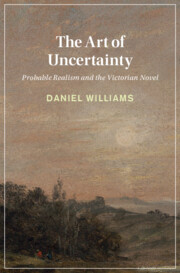Book contents
- The Art of Uncertainty
- Cambridge Studies in Nineteenth-Century Literature and Culture
- The Art of Uncertainty
- Copyright page
- Epigraph
- Contents
- Illustrations
- Acknowledgments
- Introduction
- Part I Provisional Judgments
- Chapter 1 Indecision Theory
- Chapter 2 Unproven Verdicts
- Part II Probable Realisms
- Coda
- Notes
- Bibliography
- Index
- Cambridge Studies In Nineteenth-Century Literature And Culture
Chapter 2 - Unproven Verdicts
Collins and Legal Uncertainty
from Part I - Provisional Judgments
Published online by Cambridge University Press: 29 February 2024
- The Art of Uncertainty
- Cambridge Studies in Nineteenth-Century Literature and Culture
- The Art of Uncertainty
- Copyright page
- Epigraph
- Contents
- Illustrations
- Acknowledgments
- Introduction
- Part I Provisional Judgments
- Chapter 1 Indecision Theory
- Chapter 2 Unproven Verdicts
- Part II Probable Realisms
- Coda
- Notes
- Bibliography
- Index
- Cambridge Studies In Nineteenth-Century Literature And Culture
Summary
The Victorian era is often seen as solidifying modern law’s idealization of number, rule, and definition. Yet Wilkie Collins thwarts the trend toward “trial by mathematics” and “actuarial justice” by adopting an antinumerical example as the basis for a literary experiment. The bizarre third verdict (“not proven”) of Scots law, which falls between “guilty” and “not guilty” and acts as an acquittal that nonetheless imputes a lack of evidence for conviction, structures his detective novel The Law and the Lady (1875). Revealing Collins’s sources in trial reports and legal treatises, this chapter shows how uncertainty inflects judicial reasoning and models of reading. The verdict of “not proven” undercuts the truth claims of binary judgment at law, subverts normative categories, and allows for more flexible visions of social judgment. Collins makes visible a counter-trend to certainty and closure in legal institutions and Victorian novels about the law. The chapter briefly treats Anthony Trollope’s Orley Farm (1862) and Mary Braddon’s An Open Verdict (1878), which also promote types of inference and models of critical judgment that value the tentative, hesitant, and processual, evading the calculative pressures of nineteenth-century law and life.
- Type
- Chapter
- Information
- The Art of UncertaintyProbable Realism and the Victorian Novel, pp. 78 - 106Publisher: Cambridge University PressPrint publication year: 2024

